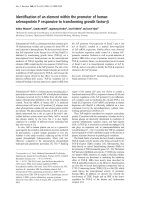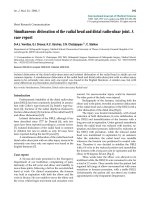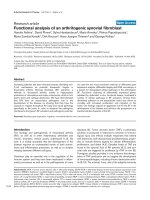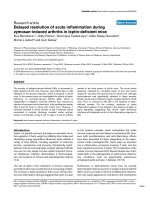Báo cáo y học: "Delayed presentation of an isolated gallbladder rupture following blunt abdominal trauma: a case report." ppsx
Bạn đang xem bản rút gọn của tài liệu. Xem và tải ngay bản đầy đủ của tài liệu tại đây (193.05 KB, 3 trang )
BioMed Central
Page 1 of 3
(page number not for citation purposes)
Journal of Medical Case Reports
Open Access
Case report
Delayed presentation of an isolated gallbladder rupture following
blunt abdominal trauma: a case report
Jonathan Bainbridge
1
, Hossam Shaaban*
1,2
, Nick Kenefick
1
and
Christopher P Armstrong
1
Address:
1
Department of Surgery, North Bristol NHS Trust, Bristol, UK and
2
Clinical Fellow Upper GI Surgery, Southmead Hospital, Bristol, BS10
5NB, UK
Email: Jonathan Bainbridge - ; Hossam Shaaban* - ;
Nick Kenefick - ; Christopher P Armstrong -
* Corresponding author
Abstract
Background: Blunt injuries to the gallbladder occur rarely, and the incidence of isolated damage
to the gallbladder is even smaller. We report a case of delayed presentation of isolated rupture of
the gallbladder following blunt trauma to the abdomen.
Case presentation: A 65 year old lady presented through the Emergency Department with a 1
week history of blunt trauma to her abdomen. She complained of continued epigastric pain which
radiated through to her back and right upper quadrant. On presentation, the patient had a low
grade temperature, hypotension and mild tachycardia. Abdominal examination revealed right upper
quadrant tenderness with no localised peritonism. C-reactive protein was 451. An abdominal CT
showed a moderate amount of ascitic fluid in the perihepatic space. The patient underwent a
laparotomy, which revealed a ruptured gallbladder with free bile. There was no evidence of any
associated injuries to the surrounding organs. Partial cholecystectomy was done in view of the
friable nature of the gallbladder. Post operatively, a persistent bile leak was managed successfully
with endoscopic sphincterotomy and stenting.
Conclusion: Rupture of the gallbladder due to blunt injuries to the abdomen occurs from time to
time and may constitute a diagnostic challenge especially with delayed presentation. Partial
cholecystectomy is a safe option in cases where friability of the wall renders formal
cholecystectomy inadvisable. Endoscopic sphincterotomy and stenting is a safe and effective
treatment for persistent post operative bile leaks.
Background
Blunt injuries to the gallbladder occur rarely, and the inci-
dence of isolated damage to the gallbladder is even
smaller [1-3]. The delay in presentation of the injury is not
unusual. Significant morbidity or even mortality can
result from delay in diagnosis, which can easily occur due
to both rarity of the condition and low amplitude of
symptoms. It is very important to bear in mind the possi-
bility of such injury when confronted with a case of upper
abdominal pain following blunt abdominal trauma. We
Published: 16 July 2007
Journal of Medical Case Reports 2007, 1:52 doi:10.1186/1752-1947-1-52
Received: 30 March 2007
Accepted: 16 July 2007
This article is available from: />© 2007 Bainbridge et al; licensee BioMed Central Ltd.
This is an Open Access article distributed under the terms of the Creative Commons Attribution License ( />),
which permits unrestricted use, distribution, and reproduction in any medium, provided the original work is properly cited.
Journal of Medical Case Reports 2007, 1:52 />Page 2 of 3
(page number not for citation purposes)
report a case of delayed presentation of isolated rupture of
the gallbladder following blunt trauma to the abdomen.
A literature review on this subject is also provided.
Case presentation
A 65 year old lady presented through the Emergency
Department with a 1 week history of abdominal pain after
being knocked down by a horse she was holding, which
resulted in the patient falling onto a stony path and hit-
ting the right side of her abdomen. She complained of
continued epigastric pain following the incident, which
radiated through to her back and right upper quadrant.
On examination the patient had a low grade temperature
(37.5°C) and was hypotensive at 96/61 mmHg, with a
pulse rate of 96. Abdominal examination revealed right
upper quadrant tenderness with no localised peritonism.
Bloods showed a normal full blood count, lipase and liver
function but did however reveal a C-reactive protein of
451. Chest and abdominal radiographs were normal with
no signs of free air. An abdominal computed tomogram
(CT) was performed which showed a moderate amount of
ascitic fluid in the perihepatic space, around the porta
hepatis and extending down to the pelvis.
The patient underwent a laparotomy, which revealed a
ruptured gallbladder with free bile. There was no evidence
of any associated injuries to the surrounding organs. Due
to the friable nature of the gallbladder and associated
inflammation cholecystectomy would have been
extremely difficult. Therefore the decision was made to
perform a partial cholecystectomy, below the level of the
tear, and drainage.
Unfortunately the drain came out unintentionally 3 days
after the operation having drained almost 200 mls of bile
in that period. There was continued leakage of bile
through the drain site increasing in rate to approximately
300 mls per day for the next 48 hours. An abdominal
ultrasound at the time showed a continued fluid collec-
tion in the pelvis.
Due to the continued bilious drainage the patient under-
went an endoscopic retrograde cholangiopancreatogra-
phy (ERCP) on day 6 post-op. During this procedure a
sphincterotomy was performed and a pig-tail stent
inserted to allow drainage of the gallbladder. Following
this intervention the patient's post-op course was unre-
markable apart from a small wound infection. She was
eventually discharged home 26 days after admission and
the stent was removed 2 months later.
Discussion
Blunt injuries to the gallbladder occur rarely, ranging from
1.9%, as reported by Penn [4], to 2.1% in the series of
patients examined by Soderstrom et al [5]. The incidence
of isolated damage to the gallbladder is even smaller, as
shown in Soderstrom's review whereby only 5 out 30
cases of gall bladder injuries were isolated. This was also
demonstrated by Wiener et al [6], showing that only half
of the cases of gallbladder injury were in isolation.
The majority of gallbladder injuries occur following
motor vehicle incidents [5-7], significant falls and direct
blows in sport e.g. soccer [8], wrestling [9] and rugby [10].
Although there has been an isolated case of injury second-
ary to a bull head-butting a patients' abdomen [6], there
are no identifiable cases of damage occurring with this
mechanism of injury. It should also be noted that the
patient had eaten in the period preceding the trauma, and
therefore the gallbladder was not enlarged in its fasted
state. Both the degree of trauma and the absence of any
collateral damage make this a unique case to report.
The delay in presentation of the injury is not unusual.
Damage to a non-infected gallbladder can cause leakage
of sterile bile into the abdomen. This in itself does not
present acutely and such injuries can take up to six weeks
to become apparent [6,11]. The majority of these cases
will be diagnosed peri-operatively, as with our case,
although a few cases have demonstrated gallbladder dam-
age using pre-operative computerised tomography [10].
The recommended treatment of gallbladder rupture and
major tears is cholecystectomy [5,6,11]. In this case the
delayed nature of the presentation resulted in an
extremely friable gallbladder, which was not amenable to
a total cholecystectomy. This resulted in a partial chole-
cystectomy being performed, also being a recognised
treatment option in such cases. Laparoscopic cholecystec-
tomy is advocated to be a safe and effective procedure in
the diagnosis and management of traumatic gall bladder
rupture [1]. In our case, however, due to uncertainty of the
diagnosis, an exploratory laparotomy was elected as the
safest option.
Endoscopic procedures such as sphincterotomy and tem-
porary biliary stenting are well known for their safety and
efficacy in the management of persistent biliary leakage
post hepatobiliary surgery [12,13]. These procedures act
by lowering the pressure at the sphincter of Oddi. This
encourages preferential drainage of bile to the duodenum
rather than leaking into the peritoneal cavity.
Conclusion
Rupture of the gallbladder due to blunt injuries to the
abdomen occurs from time to time and may constitute a
diagnostic challenge especially with delayed presentation.
Partial cholecystectomy is a safe option in cases where
inflammation and friability of the wall render formal
Publish with BioMed Central and every
scientist can read your work free of charge
"BioMed Central will be the most significant development for
disseminating the results of biomedical research in our lifetime."
Sir Paul Nurse, Cancer Research UK
Your research papers will be:
available free of charge to the entire biomedical community
peer reviewed and published immediately upon acceptance
cited in PubMed and archived on PubMed Central
yours — you keep the copyright
Submit your manuscript here:
/>BioMedcentral
Journal of Medical Case Reports 2007, 1:52 />Page 3 of 3
(page number not for citation purposes)
cholecystectomy inadvisable. Endoscopic sphincterotomy
and stenting is a safe and effective treatment for persistent
post operative bile leaks.
Competing interests
The author(s) declare that they have no competing inter-
ests.
Authors' contributions
JB is the principal author of the paper, HS participated in
collecting data and wrote the endoscopy part of the dis-
cussion, NK revised and edited the whole document; CA
supervised the project and undertook the final revision
before submission. All authors read and approved the
final manuscript.
Acknowledgements
Full informed and written consent has been obtained from the patient for
submission of this manuscript to be published.
References
1. Liess BD, Awad ZT, Eubanks WS: Laparoscopic cholecystectomy
for isolated traumatic rupture of the gallbladder following
blunt abdominal injury. J Laparoendosc Adv Surg Tech A 2006,
16(6):623-5.
2. Salzman S, Lutfi R, Fishman D, Doherty J, Merlotti G: Traumatic
rupture of the gallbladder. J Trauma 2006, 61(2):454-6.
3. Carrillo EH, Lottenberg L, Saridakis A: Blunt traumatic injury of
the gallbladder. J Trauma 2004, 57(2):408-9.
4. Penn I: Injuries of the gallbladder. Br J Surg 1962, 49:636.
5. Soderstrom CA, Maekawa K, DuPriest RW Jr, Cowley RA: Gallblad-
der injuries resulting from blunt abdominal trauma. Ann Surg
1981, 193:60-6.
6. Wiener I, Watson LC, Wolma FJ: Perforation of the gallbladder
due to blunt abdominal trauma. Arch surg 1982, 117:805-7.
7. Greenwald G, Stine RJ, Larson RE: Perforation of the gallbladder
following blunt abdominal trauma. Ann Emerg Med 1987,
16(4):452-4.
8. Johnson WR, Harris P: Isolated gallbladder injury secondary to
blunt trauma: case report. Aust N Z J Surg 1982, 52:495-6.
9. Wilton PW, Fulco J, O-Leary J, Lee JT: Body slam is no sham. N
Engl J Med 1985, 313:188-9.
10. Kohler R, Millin R, Bonner B, Louw A: Laparoscopic treatment of
an isolated gallbladder rupture following blunt abdominal
trauma in a schoolboy rugby player. Br J Sports Med 2002,
36:378-379.
11. Sharma O: Blunt gallbladder injuries: Presentation of twenty-
two cases with review of the literature. J Trauma 1995,
39:576-80.
12. Lubezky N, Konikoff FM, Rosin D, Carmon E, Kluger Y, Ben-Haim M:
Endoscopic sphincterotomy and temporary internal stenting
for bile leaks following complex hepatic trauma.
Br J Surg
2006, 93(1):78-81.
13. Christoforidis E, Goulimaris I, Tsalis K, Kanellos I, Demetriades H,
Betsis D: The endoscopic management of persistent bile leak-
age after laparoscopic cholecystectomy. Surg Endosc 2002,
16(5):843-6. Epub 2002 Feb 8









